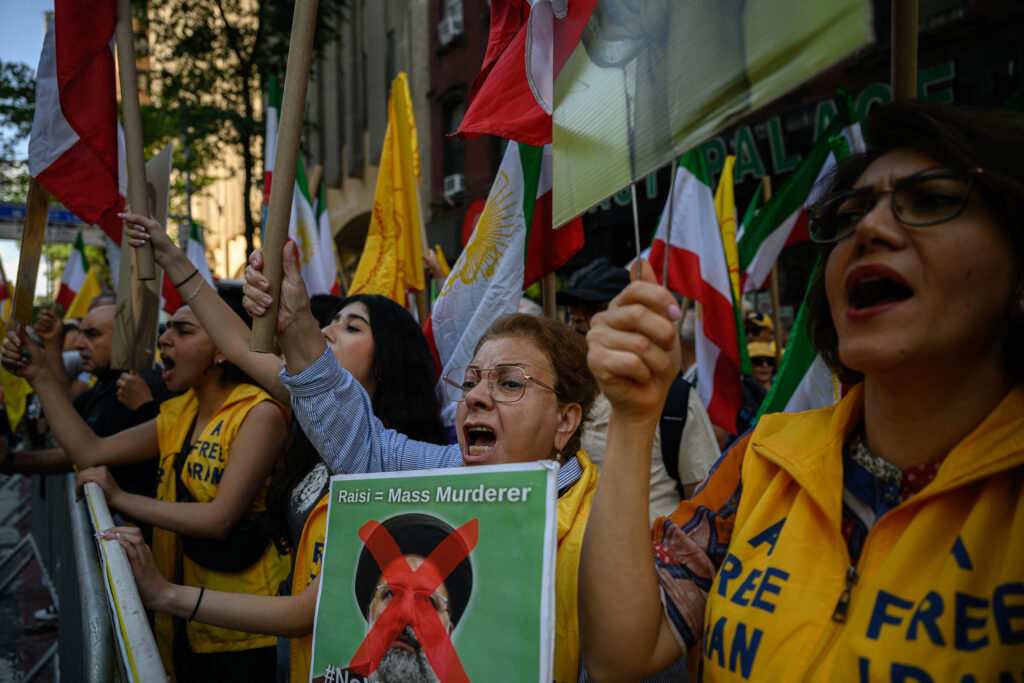Violence erupted in Iran’s capital and three were killed in the northwest province of Kurdistan, as security forces cracked down on the biggest public backlash against the country’s dress code for women since the 1979 revolution that ushered in the laws.
Riot police used water cannon and fired tear gas to disperse crowds in Tehran after hundreds of demonstrators skirmished with security forces on Monday. The outpouring of public anger was sparked by the death of Mahsa Amini, a 22-year-old woman who fell into a coma and died after being detained by “morality police” last week because of how she was dressed.

Three were killed during protests in Kurdistan, state-run Islamic Republic News Agency reported, citing the province’s governor who suggested that “terrorist groups” were responsible for the deaths. Authorities often refer to protesters as seditionists and terrorists. Clashes had broken out over the weekend in Amini’s hometown of Saghez in Kurdistan, where she was buried on Saturday.
There were also rallies at major universities in Tehran, Tasnim reported, while unconfirmed reports and video footage show that demonstrations had spread to other cities including Tabriz and Hamedan.
Videos posted on social media showed protesters chanting “death to the dictator,” “women, life, freedom” and “I’ll kill whoever killed my sister” against a backdrop of armed officers and black police vans. In some clips members of the public can be seen retaliating at members of a voluntary, plain-clothed militia who are run by the Islamic Revolutionary Guard Corps and often deployed to infiltrate and sometimes violently break up protests.
Other footage included a woman standing on a car bonnet and setting fire to her headscarf, as well as a burning dumpster and police motorbike in flames. The videos couldn’t be independently verified by Bloomberg.
The unrest is some of the most violent in Iran since November 2019 protests over fuel prices and it comes as Iran’s hard-line President Ebrahim Raisi — a cleric who has spent much of his career helping to define the country’s Islamic laws — makes his first physical appearance at the United Nations General Assembly in New York.
He’ll be accompanied by Iran’s foreign minister and chief nuclear negotiator, who are expected to meet diplomats on the sidelines to address the latest deadlock facing talks to revive the 2015 nuclear deal.
Amini’s death will likely overshadow Raisi’s U.N. visit as the chorus of voices condemning the incident grows louder. On Tuesday, the U.N.’s acting High Commissioner for Human Rights, Nada Al-Nashif, urged an impartial investigation.
Earlier, U.S. Secretary of State Antony Blinken said in a tweet: “Mahsa Amini should be alive today. Instead, the United States and the Iranian people mourn her. We call on the Iranian government to end its systemic persecution of women and to allow peaceful protest.”
In a statement, Tehran police said Amini suffered “heart failure” on Friday while in a coma following her detention by officers of the city’s so-called morality unit.
Police chief General Hossein Rahimi called her death an “unfortunate incident,” ruling out any wrongdoing by his personnel, the semi-official Tasnim news agency reported. Iran’s parliament has said it launched an investigation and was seeking to reform laws governing how the morality police patrols are used and deployed.
The Donya-e-Eqtesad newspaper cited Amini’s father, Amjad Amini, as saying that she had no preexisting illness when detained. He accused authorities of beating her and then covering up their actions. “We won’t let her blood go in vain,” the daily reported him as saying.
Iran’s morality police crack down on dress they say violates Islamic codes. But critics say their approach is arbitrary and that they embody efforts by the government to enforce hard-line religious beliefs on women and girls. The units have been widely disliked for years and often draw vocal criticism from reformists, public figures and moderate clerics.
The internet was disrupted in parts of Kurdistan province as the protests took place, digital watchdog group NetBlocks said. Residents near the demonstrations and in Tehran also reported connectivity issues. Internet disruptions during times of protest in Iran are common and access to the web was banned entirely in November 2019 when widespread protests over fuel prices turned deadly.
Rahimi, Tehran’s police chief, said Amini was arrested as her “leggings were problematic,” according to comments published in Iran’s leading reformist newspaper, Shargh.
Women in Iran have been subject to mandatory Islamic dress codes since the 1979 revolution that stipulate a “chador” — a black cloak that envelopes the body from head to toe — or long, loose-fitting overcoats and tightly worn head scarves.
Over the years, though, enforcement of the rules has fluctuated and women have gradually challenged the boundaries of what’s permissible. In urban centers in particular, loose head scarves and leggings worn with over-sized robes are common — similar to the clothes Amini appeared to be wearing in CCTV footage recorded inside the police station and broadcast on state TV.
The morality police, who patrol cities with minivans seizing mostly young people and women in the street, has increased its activity since the election of Raisi last year. Security forces have increasingly pushed back against public displays of dissent since early 2018, when several women were arrested for removing their headscarves in public.
Authorities already use vehicle number plate detection to target women drivers deemed inadequately veiled and have announced plans to introduce face-recognition software to prosecute women more vigorously.
___
© 2022 Bloomberg L.P Distributed by Tribune Content Agency, LLC



